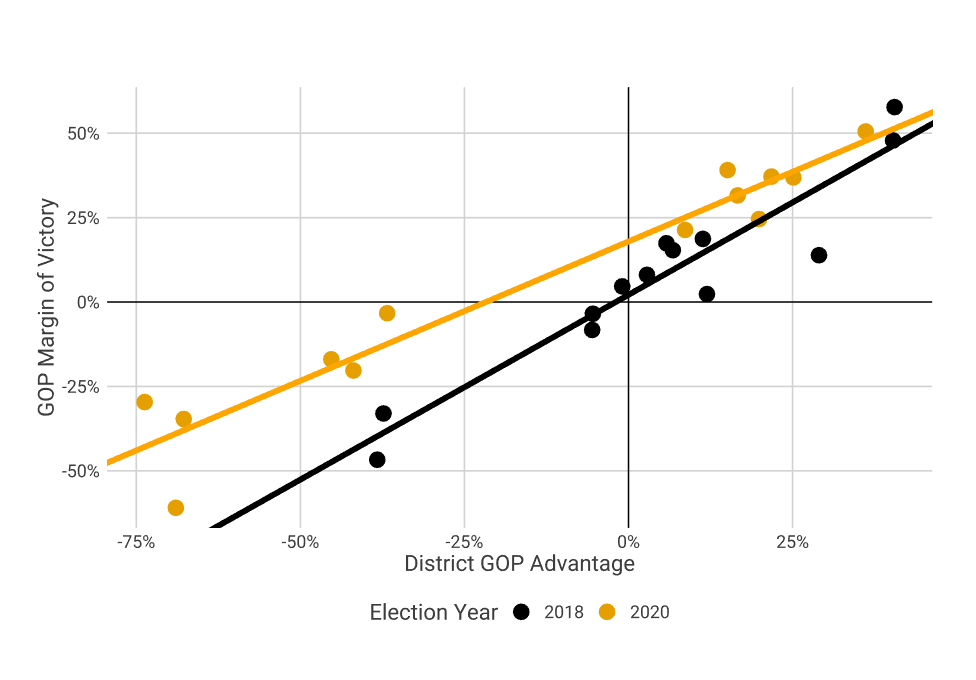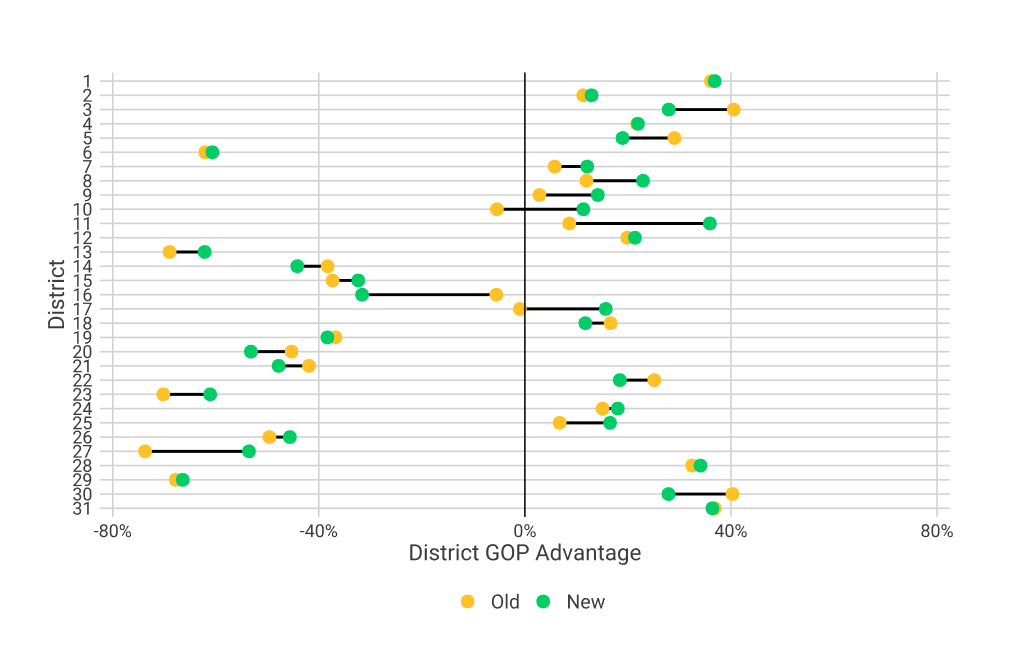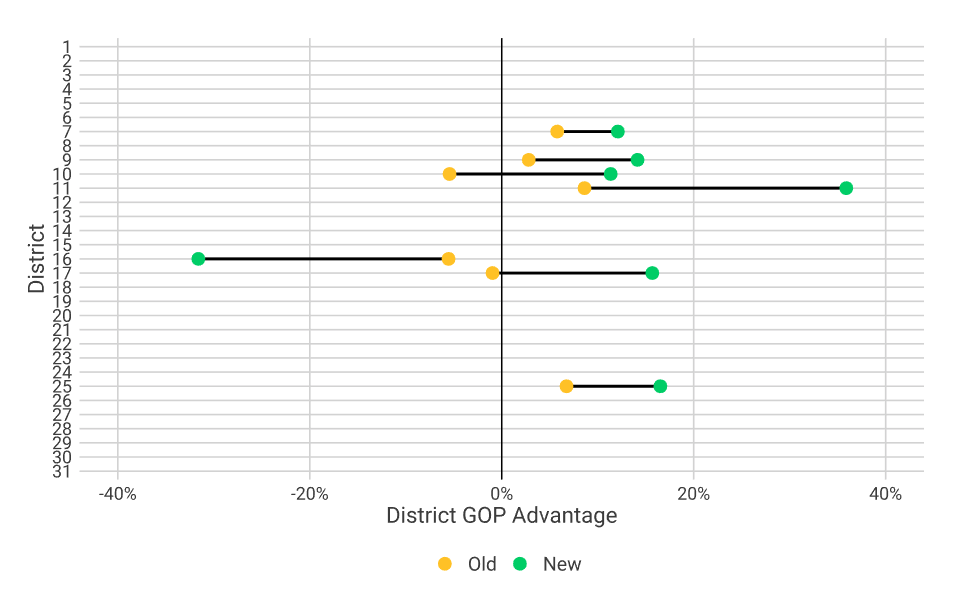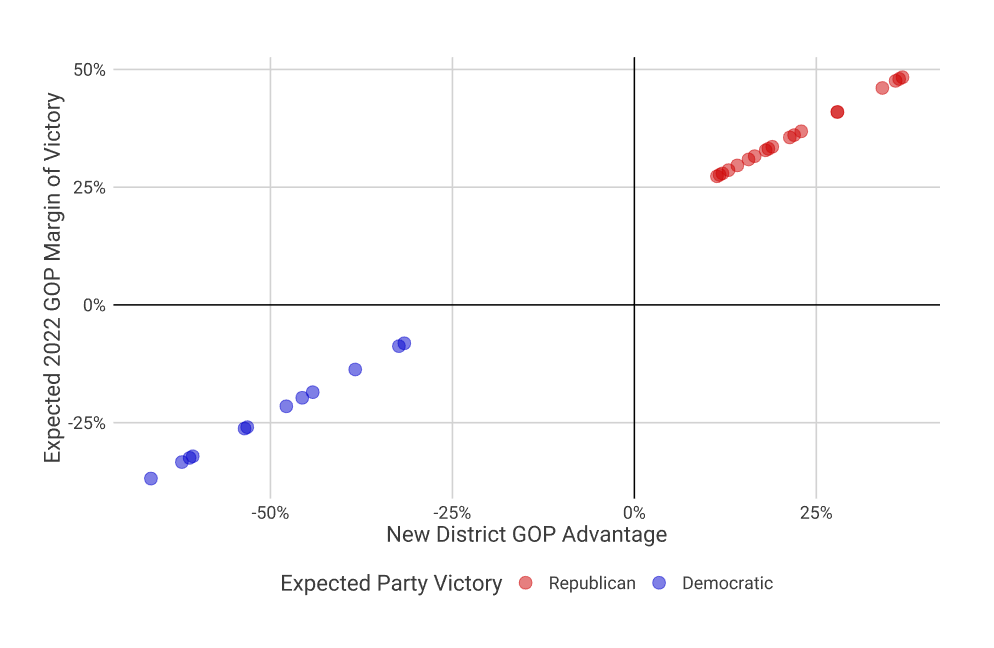Blog: Texas Senate Redistricting: A Statistical Analysis
Texas Senate Redistricting: A Statistical Analysis
On October 25th, Texas Governor Greg Abbott put pen to paper and signed off on new maps for Texas’ Senate districts. This capped-off the arduous redistricting process which takes place every ten years, meant to account for population shifts measured in the decennial censuses. Barring any judicial orders to redesign the new districts, the new map will take effect for the 2022 primary and general election seasons. So, we decided to dig deep into the numbers and estimate how the newly-drawn lines will affect Texas Senate races in 2022. Spoiler alert: the GOP benefits.
Currently, Republicans control 18 of the 31 seats in the Texas Senate, and Democrats occupy the other 13. Despite the demographic shifts taking place in Texas, the fact remains that it is certainly a conservative-leaning state, and its legislature reflects that. Interestingly, though, Republican candidates often even outperform the intrinsic partisan advantages they’re afforded. Allow me to explain.
The Built-in Conservative Advantage
The chart below shows how much the Republican won (or lost) by in each of the 26 most recent regular Texas Senate races in which both a Republican and a Democrat ran. There were 3 seats in which no Republican ran and 2 seats in which no Democrat ran, but these seats were excluded in order to analyze what happens when Republicans and Democrats face off against one another.

The other variable included in this chart, District GOP Advantage, measures the partisan advantage the GOP enjoys in that district. This is calculated by subtracting the percentage of likely voters in the district who are modeled as Democrats from the percentage of likely voters in the district who are modeled as Republicans. Essentially, a District GOP Advantage of 10% simply means that Republican voters make up 10% more of the district’s electorate than Democratic voters do.
Here’s where things get interesting. When you separate the elections by which year they took place (2018 or 2020) and generate a regression line to fit the data, you notice that the 2018 line (black) has a steeper slope than the 2020 line (orange), but the 2020 line has a higher intercept. The steepness measures how much the District GOP Advantage correlated with the election’s outcome, and the intercept measures the “built-in” advantage (or disadvantage) Republican candidates had that year, regardless of the District GOP Advantage. But why does this matter?
Well, this intercept is one of the most effective and empirical ways to measure a party’s performance in an election year. In 2018, widely dubbed the “Blue Wave” due to Democrats’ impressive national gains in that year’s elections, the GOP Margin of Victory intercept was only 2.1%, meaning that in a district whose likely voters were equally split between Democrats and Republicans, the Republican candidate would be expected to win by an average of 2.1%. In contrast, that number jumped to 17.9% in 2020, a more “typical” election year – at least in terms of partisan turnout. In other words, Republicans had a much better year in 2020.
Direct Effects of Texas Senate Redistricting
But what does all of this have to do with redistricting? Well, the purpose of fitting a regression model to the data was to derive a formula that predicts an election outcome based on the District GOP Advantage. While we don’t yet know what the election outcomes will be in each redistricted seat, we do know the District GOP Advantage for each new district. Thus, we can predict the results of the 2022 Texas Senate elections by plugging in the new District GOP Advantage values into one of the models we generated based on previous election data.
But before we jump into the results of applying this model to predict 2022 outcomes, let’s first examine how each district’s GOP Advantage changed after the redistricting process. The following chart shows which party benefited from redistricting in each district, and by how much.

After considering the above chart for a few moments, three main patterns become apparent.
- First, you’ll likely notice the right-most quadrant of the chart (>40% District GOP Advantage) is almost entirely empty, while the left-most quadrant (>40% Democratic Advantage) is much more crowded. What this means is that there are many more “packed” Democratic districts (8 old districts, 9 new districts) than “packed” Republican districts (2 old districts, 0 new districts). When Democratic voters are consolidated into districts with an extremely overwhelming Democratic majority, it makes it easier for Republican-leaning districts to form, as the largest chunks of the Democratic base have already been removed from the equation. But wait - this doesn’t necessarily mean Republicans committed any foul play in order to make this happen. Democratic bases are often naturally consolidated in inner cities, while Republican electorates are typically spread out over wider distances, often with Democratic enclaves.
- Next, redistricting “reined in” the partisan advantages in many of the most partisan districts. For instance, the three districts with the greatest GOP Advantage lost some of their advantage after redistricting, as did the five districts with the greatest Democratic Advantage. In practicality, this has few implications, as these districts retained a heavy partisan advantage.
- Finally, the districts closest to the 0% Advantage line (i.e. the most competitive districts) moved farther to one side or the other. In fact, of the seven Texas Senate districts with a partisan advantage of 10% or less, every single one of them gained a partisan advantage of 10% or more after redistricting. Six of these districts gained a 10% or more Republican advantage, while only one gained a 10% or more Democratic advantage. The below chart isolates these seven districts, showing how almost all of them shifted to the right quite substantially.

Pay special attention to District 10 in the above graph, which shifted from a 5.4% Democratic Advantage to an 11.4% Republican advantage. Incumbent Senator Beverly Powell (D) would almost certainly lose her seat in the next election cycle, and has now filed a lawsuit alleging that the new district dilutes the minority vote.
But of all the graphs we’ve presented thus far, none exemplifies the direct partisan effects of redistricting quite as succinctly as the one below. Districts with no clear partisan advantage (i.e. those surrounding the 0% Advantage line) got pushed to one side or another, while those with the largest partisan advantages (i.e. those on the fringes) got pushed towards the middle.

Statistical Predictions for the 2022 Texas Senate Elections
Now, it’s time to discuss why redistricting even matters in the first place: elections. In the 2022 election cycle, the new districts will take effect for the very first time. And as discussed earlier, we can use past election data relating the District GOP Advantage to the GOP Margin of Victory to predict future election results.
But that brings us to our next question: should we use the data from 2018 model or the data from 2020? Since most politicos expect Republicans to perform at least as well in 2022 as they did in 2020, we’ll use the 2020 regression model to predict 2022 results. Here’s the formula:
GOP Margin of Victory = (0.82518 x District GOP Advantage) + 17.941%
By plugging in the new District GOP Advantage values, we can predict whether the Republican or Democratic candidate will win in each 2022 Texas Senate race, and by how much. The below chart displays the results of this prediction model.

As shown above, the model predicts Republicans to win 19 of the 31 Texas Senate seats in 2022, a 1-seat gain compared to their current 18 seats. However, it should be noted that all 19 of these seats are predicted to be won by a significant margin - in fact, by more than 25%. Democrats, on the other hand, are facing much more of an uphill battle. Exactly half of the seats they’re expected to win in 2022 are predicted to be decided by a margin less than 25%, giving Republicans opportunities to pick up even more seats, especially if they perform even better than expected.
A natural question might be: “Which currently Democratic seat is predicted to flip red in 2022 to give Republicans a 19-12 majority instead of 18-13?” Well, this is where District 10 once again comes into play. We’ve already discussed how Democratic Sen. Beverly Powell is suing over her district’s significant shift to the right, and it turns out that that might be her only hope of remaining in office. Our model predicts that her district will be won by a Republican candidate by a margin of approximately 27.3%, which is music to Republicans’ ears and a worst nightmare for Sen. Powell.
All in all, the Texas Senate redistricting process decreased the number of tossup districts in favor of creating more heavily Republican or Democratic districts. And while a few Democratic incumbents gained a stronger partisan hold on their district (5 of them, to be exact), Republicans were the overwhelming winners of this redistricting process. Despite all the talk of Texas becoming “California-ized” with the massive influx of new residents, don’t expect the Texas Senate to turn blue anytime soon - especially not before another round of redistricting.










